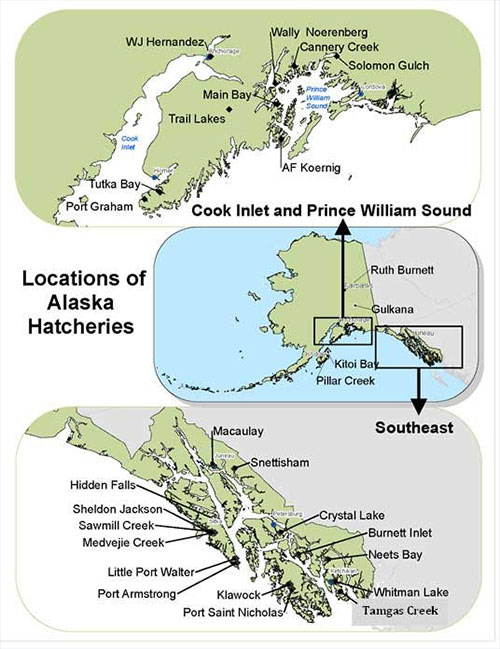|
Fish Factor 8th largest salmon hatchery home-coming since 1977By LAINE WELCH
March 21, 2022
An additional 220-thousand salmon that got their start in a hatchery also were caught in Alaska sport, personal use and subsistence fisheries. Nearly 70 million adult hatchery salmon returned last year, according to the annual salmon enhancement report by the Alaska Dept. of Fish and Game. Pinks comprised the bulk of the pack topping 57 million, followed by chum salmon at 9.4 million.
Currently, 30 salmon hatcheries operate in Alaska. Twenty-six are operated by private nonprofit corporations and are funded primarily from the sale of a portion of the returning fish. Of these, 11 are state-owned and operate at no cost to Alaska. The state also operates two sport fish hatcheries, one research hatchery is run by NOAA Fisheries, and the Metlakatla Indian Community also owns and operates a hatchery. At a glance: Prince William Sound had the highest number of hatchery returns in 2021 at 48.2 million salmon. Nearly 40 million were caught in the commercial fisheries, worth almost $68 million to fishermen, or 62% of the dockside value. Pink salmon contributed the most at $49 million. Kodiak ranked second for hatchery salmon returns at 11.6 million fish. That produced a catch of more than eight million fish worth $10 million to fishermen. Pink salmon contributed most to the value at over $8 million, followed by sockeyes at $1.5 million. Southeast Alaska had a total return of 8.2 million hatchery salmon and nearly five million were caught valued at $32 million to fishermen, or 27% of the region’s dockside value. Cook Inlet ranked fourth for hatchery returns at 827,000 salmon. The fish contributed about 134,000 salmon to the Inlet’s commercial fishery valued at $946,000, or 5% of the value to fishermen. Sockeye salmon paid out the most by far at $908,000, followed by pink salmon at $38,000. Since 1995, annual releases by Alaska’s combined hatcheries have ranged from 1.4 to 1.8 billion juvenile salmon About 1.7 billion fish were released in 2021, mostly from eggs collected in 2020. They included 870 million pink salmon and 750 million chums. Alaska hatchery operators expect a total return of just over 44 million salmon in 2022. Fish names needed: The Alaska Board of Fisheries (BOF) is minus one member as it wraps up its meeting cycle through April 2, and two more seats become vacant in June. The BOF is meeting through March 22 in Anchorage to address nearly 160 management proposals for Southeast and Yakutat subsistence, commercial, sport and personal use fisheries. A day-long hatchery committee meeting is set for March 23, followed from March 26 through April 3 by shellfish issues at Cook Inlet, Kodiak and the westward region, the Arctic and shrimp management at Prince William Sound. Governor Mike Dunleavy has yet to appoint someone to fill the seat of Indy Walton of Soldotna who resigned from the BOF in December after serving just three months. By Alaska law, Dunleavy was required to name a replacement within 30 days of a seat becoming vacant. Members Israel Payton of Wasilla and Gerad Godfrey of Eagle River do not plan to continue on the BOF, according to board director Glenn Haight. Currently, only one of the seven Fish Board seats is held by a member from a coastal region – John Jensen of Petersburg – and none is from the commercial fishing sector. “Yep - the body that regulates pretty much everything to do with commercial fishing in state waters doesn't have a single commercial fisherman on board. None. Nada. Zero. Zilch. Amazing,” commented the Fish Ticket by Alaska Boats and Permits in Homer. Insiders say there is a power struggle between legislators and industry stakeholders who want more commercial fishing representation on the BOF, while the governor wants more sport fishing voices. Fish give back: Western Alaska communities are invited to submit applications for grants from American Seafoods Company. A total of $45,000 will be given out in this round with the majority of awards ranging from $1,000 to $7,500 for projects that address social needs and food security. Another $45,000 will be awarded in October. Grant applicants can hail from Kodiak Island, the Aleutian and Pribilof Islands and Western Alaska Peninsula, Bristol Bay, the Lower Kuskokwim, Lower Yukon, Norton Sound and regions north. The deadline to apply is April 18; recipients will be announced by an advisory board on May 5. Since 1997, American Seafoods has granted over $1.8 million to organizations and programs in Alaska through its grant program. Request forms are available online at www.americanseafoods.com or by contacting Kim Lynch (kim.lynch@americanseafoods.com (206-256-2659).
SitNews ©2022 Stories In The News Ketchikan, Alaska
|
||||

